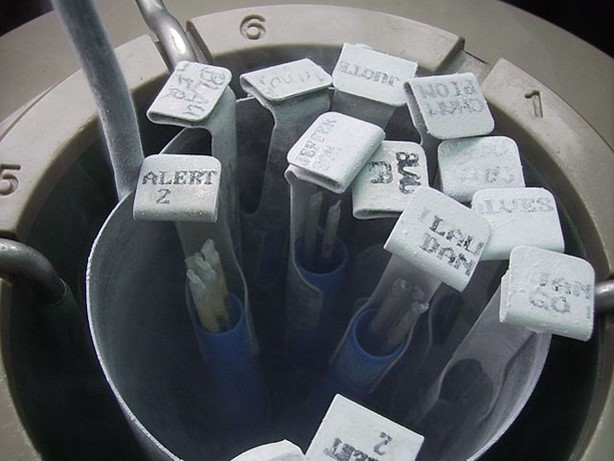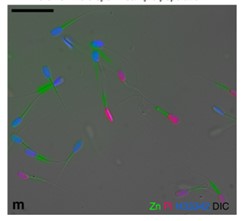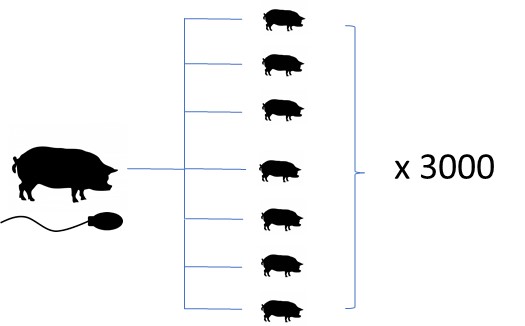



Maximise your chances: New research highlights function of zinc in boar fertility
The Pig Site speaks to Karl Kerns, fertility researcher at the University of Missouri and author of a recently published study investigating the true function of zinc in sperm maturation and swine fertilityResearchers at the University of Missouri found that zinc plays a key role in promoting fertility in males, a discovery that has implications for improved in vitro fertilisation and artificial insemination in livestock and for human infertility diagnostics and therapies.
The study demonstrated the ability to quickly and accurately evaluate the fertility of livestock or humans by analysing their sperm cells with a flow cytometer. This allows for more informed decision-making when it comes to alternative processes like in vitro fertilisation and artificial insemination. For example, sperm cells are traditionally “diluted” before artificial insemination into livestock, which eliminates some of the zinc. Preserving the zinc would lead to healthier sperm and a greater ability to identify infertility.
The Pig Site speaks to Karl Kerns to find out more on how these findings came about:
What is sperm capacitation and why is it such an important step of sperm maturation?
Sperm capacitation was first defined in the 1950s by Austin and Chang.
Sperm, when they are first collected from the boar, are not capable of fertilising an egg. The sperm must undergo this last maturation step, called capacitation – the acquisition of the capacity to fertilise an oocyte.
It is very important to understand what the mechanisms of capacitation are, because that way we can handle the boar semen in ways that don’t prematurely capacitate them. Once capacitation starts, it shortens the lifespan of sperm significantly.
In terms of storage and transportation it reduces the time slot that you’ve got?
Exactly! Sperm are also supposed to capacitate sequentially – there is always some capacitating occurring – and what we’ve come to find out is that some of the semen storage techniques don’t allow them to sequentially capacitate.

Some of the semen storage techniques used to date don’t allow sperm to sequentially capacitate, thereby reducing the longevity and quality of swine semen samples. Image: Uwemuell
What role does zinc play in sperm capacitation?
Zinc regulates sperm capacitation – as we are starting to find out. From the molecular standpoint, it inhibits HV1, a hydrogen voltage gated channel. And so, as soon as zinc is removed from that channel, it allows for the rise of the intracellular pH inside the sperm cell and that allows a cascade of events to occur downstream with all the traditional hallmarks of what we traditionally view as capacitated sperm.
Zinc is a gatekeeper, if you will.
How was the function of zinc in sperm capacitation discovered, in terms of lab procedures and the type of trials used?
Teresa Woodruff and her group at Northwestern Medical discovered what they called the ‘zinc spark’ - that’s a spark of about 3 billion ions of zinc that are released from the egg shortly after fertilisation. The group showed how the bigger the spark, the better the chances of that oocyte to be able to achieve an embryo in a separate state called a blastocyst.
They’ve done a very good job of describing zinc from the oocyte side, and so what we wanted to do was back that up and complete the biological story, in telling that story from the sperm perspective and up to fertilisation on the oocyte side.
The lab equipment that we used was state-of-the-art image-based flow cytometry, and that is essentially a high throughput imaging device that allows us to take images of thousands of sperm cells in a matter of 30-60 seconds. We can then generate all kinds of image-based values and bio-markers including in this situation, zinc and how it’s located on the sperm.
Would you have been able to complete this research without technology available?
No; so in the supplementary data file I think I’ve showed in there what a traditional flow cytometer makes sperm the results look like. You have to clean the data up and get rid of so much debris and make sure that the sperm are aligned anteriorly or posteriorly and not at a 90 degree angle. Once you have your data all cleaned up so it’s uniform images going across the sensors, then it’s necessary to have the other space for now, for the discovery. We are hoping to adapt it in the future to traditional flow cytometry.

Boar spermatozoa after 72 h of storage in Beltsville thaw solution (BTS semen extender) show varied zinc signatures. Imprecise fluorescent to bright-field overlay illustrates motile status (all scale bars: 25 μm, unless noted). ©
Kerns K, Zigo M, Drobnis EZ, Sutovsky M, Sutovsky P (2018)
Can you explain what it is that you were hoping to find out through conducting this trial?
1) To complete the biological story of zinc and the fertilisation process from the sperm point of view; and 2) We were funded by USDA, a national institute of student agriculture, so we want to bring a molecular approach to science and describe things from the molecular aspect, but then have it be translatable to agriculture. Basically, we wanted to better understand that zinc story to make real education for the swine industry.
I was also born and raised on a swine feedstock farm so my passion is boar semen and the swine industry.
How did you conduct the trial?
We had the boar semen collected using traditional techniques and then we had to use a specialised in vitro capacitation media, and that in vitro capacitation media allowed us to mimic that biological event that goes on just before fertilisation occurs. We then used an image based flow cytometer to monitor sperm capacitation and zinc concentration.
How would it mimic the conditions just before fertilisation?
We try to have a chemically defined media that mimics the oviduct and so we have key ingredients in there such as a cholesterol acceptor, as well as calcium and sodium bicarbonate and that all works together to promote capacitation and the other secret ingredient is having them at body temperature, 37 degrees Celsius.
How did you go about creating that media?
There’s been quite a few sperm capacitation medias made over the years and so ours was a little bit different from others because others’ studies forced the sperm to capacitate but we’re coming at it from the view of using it as a future fertility trial, a fertility testing mechanism. Therefore, we just give sperm enough of the ingredients that they want to capacitate, then we are able to see if some sperm capacitate too fast or too slow.
There’s a lot of making sure we have the right ingredients at the right balance.
What did your results show?
For decades we’ve known that zinc is really important for boar fertility; the literature documents that when we add zinc to the diet we can increase sperm production. We also know that the highest concentration of zinc is found in semen, but we’ve never known why. Therefore, the biggest implication of this research is that we now know how and why zinc is so important in the pathway to fertilisation.
Any surprises in the results?
It’s a completely new field so everyday there’s a surprise. I explain it to a lot of my friends that I’m like a kid in a playground – I get to go into labs and do all kinds of experiments that we don’t know anything about and every day is a new day and it’s just exciting.
What does this mean for the pig industry?
As we look at the future of the swine industry and agriculture in general, a lot of the popular terms and philosophies now are precision agriculture. I think we’re really gearing up for a second generation of artificial insemination.
What artificial insemination allowed us to do was go from one boar that could breed with 30 sows with natural agents to that one boar reproducing with 300 sows. I think we’re gearing up to one boar across 3000 sows and that has implications for a better genetic leverage so we can use a higher proportion of better genetics.
This research is all coming together to show that: 1) We need better diagnostic methods to understand sperm fertility; and secondly, that we need to re-analyse some of the artificial insemination rules that were originally made in the 1980s and haven’t been updated since then.

This research could pave the way for a new age of artificial insemination, with the potential for one boar to successfully inseminate 3000 sows
So will this make the process more efficient?
Yes – right now we inseminate on average with 3 billion sperm cells, and in the grand scheme of things, it’s dawning on us that that is way too many sperm. Once we understand that some boars are more fertile than others then we can really start reducing that sperm per dose.
What does this research really highlight to you?
I think at the end of the day, this research has implications in both animals and humans. What we don’t talk about very often is that one in eight couples suffer from infertility and a lot of the time the female gets too much of the blame when we know that 2/3 of it is directly or indirectly related to the male. When we have new analysis techniques like this, that allows us to understand that zinc may not be regulated on the male side, and it can help us make better decisions when we approach in vitro fertilisation or also just to help the emotional health of that couple.
It’s becoming more and more apparent that there is an overlap between swine and human physiology...
Yes, traditionally science has used mice for human models and medical research but we’re coming to find that a lot of the things they found on mice doesn’t work on humans, and if they were to use pigs then theories would have a better success rate.









